
Features
Structural
Training
Back to Basics: June 2012
In April, my department in Woodstock, Ont., had its first highrise fire of the year.
June 11, 2012
By Mark van der Feyst
In April, my department in Woodstock, Ont., had its first highrise fire of the year. It was on the seventh floor and was contained to a single bedroom where a piece of furniture – an upholstered chair – was on fire and created some good heat in the room. We used our highrise kit as part of the attack. The kit consists of 100 feet of one-and-three-quarter-inch hose and a 10-foot length of two-and-a-half-inch hose attached to a gated wye.
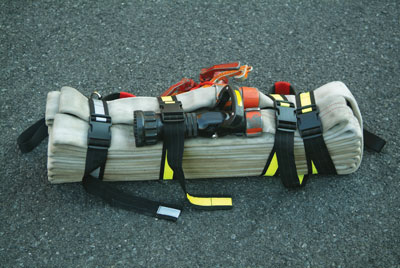 |
|
| Photo 1: A typical highrise kit, which includes an automatic combination nozzle. Kit configuration can vary, depending on manpower, water supply and operational procedures. | |
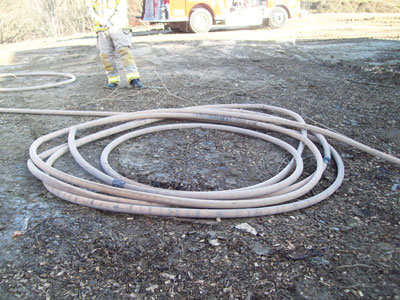 |
|
| Photo 2: The Cleveland Load makes deployment easier, quicker and kink-free. Note that the hose is charged and ready for advancement. | |
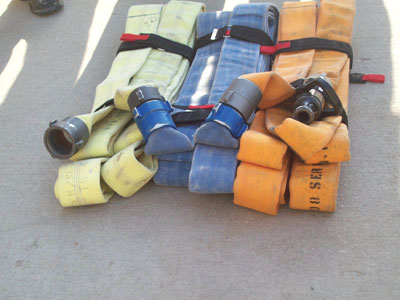 |
|
| Photo 3: This third type of highrise kit comes from New York City, and comprises three separate 50-foot bundles. Firefighters can select the appropriate hose length, making it easier to carry the hose up stairs to the hook-up floor. | |
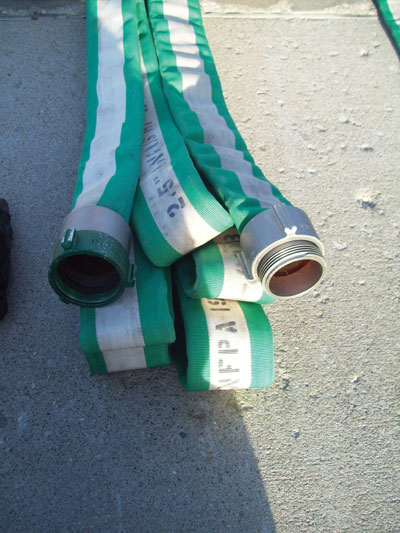 |
|
| Photo 4: When using the New York City kit, carry the line by the middle part of the hose, which sticks out between the two couplings. | |
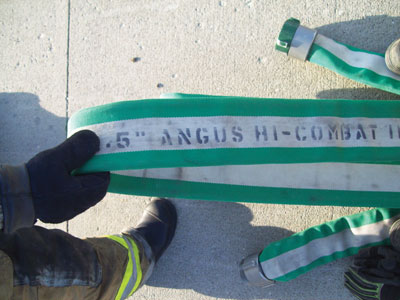 |
|
| Photo 5: Holding the middle of the line also saves time when it comes to deployment. | |
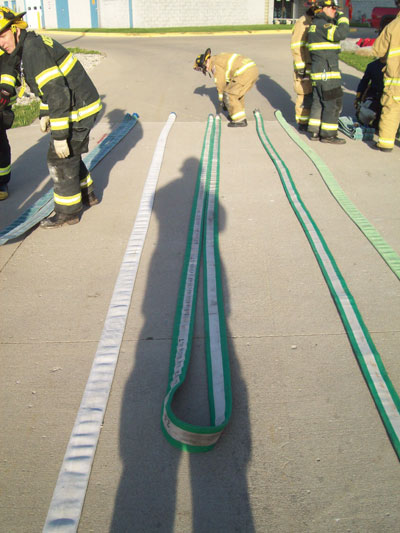 |
|
| Photo 6: To package the New York City kit, lay out the hose so the couplings are side by side. | |
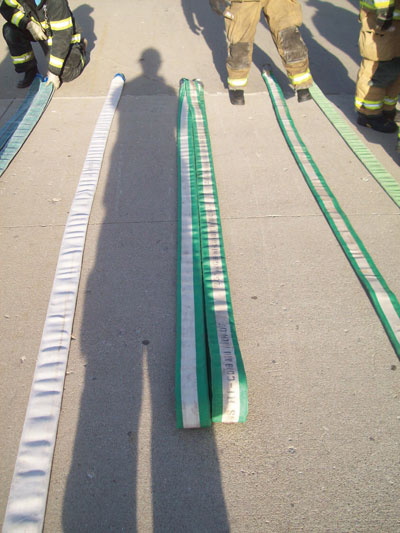 |
|
| Photo 7: Bring the bended part of the hose to lay over the couplings. Photos by Mark van der Feyst |
The gated wye gets attached to the standpipe. After a quick knockdown, the fire was extinguished and overhaul operations began. Our highrise kit, shown in photo 1, is fairly basic. There are many configurations for highrise kits, based on factors such as manpower, water supply, the department’s operational procedures, types and sizes of fire usually encountered, and ease of operation.
Our highrise kit is typical. As mentioned, the gated wye gets attached to the standpipe, which allows a secondary attack line to be attached without interrupting operations. Some gated wyes have pressure gauges, which allow firefighters to verify the amount of pressure being supplied to the line at that point. If the highrise kit uses an automatic combination nozzle as seen on photo 1, it requires 700 kilopascals (kpa), or 100 pounds per square inch (psi), at the nozzle. If the kit uses a smooth-bore nozzle, then it requires 350 kpa or 50 psi at the nozzle. Having both types of nozzles allows for a choice based on water supply, the type of building, and manpower. The lower-pressure nozzle requires less water pressure and can be handled relatively easily by one firefighter. At least two firefighters are required to operate the higher-pressure nozzle at the correct pressure. There are some automatic combination nozzles that operate at 75 psi, or 525 kpa; the lower pressure helps the firefighter use the nozzle in a highrise application.
The highrise kit needs to be deployed in a manner that requires half of the hose length to be taken up the stairs from the hook-up floor to the fire floor, and then up one more flight of stairs, looped around the outside of the stairway and taken back down to the fire-floor door. In this situation, one firefighter takes 50 feet of hose up and the other firefighter deploys the other 50 feet. All kinks must be removed to ensure that the line is completely charged at the correct pump pressure. Use of this basic type of kit can be time consuming and may not be the best option.
Another type of highrise kit is the Cleveland Load. In photo 2, the hose load is deployed, charged and ready for advancement. This type of load makes deployment easier, quicker and kink-free. The hose load is good for highrise applications as it allows a crew of two firefighters to tie into the standpipe, charge the line and then advance it to the fire floor. The key with this type of load is to make sure the load is pulled apart once on the floor, and to charge it first before advancing. If the hose is advanced before it is charged, it will not play out as intended. The hose load still has to be advanced up one flight to the fire floor; this will be the hardest part of using this type of load, because it needs to be pulled up the stairs and around corners while charged. Another factor to consider and, perhaps, a drawback of this load, is where it is being attached to the standpipe. If the standpipe is in the hallway, the load will work with few restrictions. If the standpipe is in the stairwell, then space is an issue. Even though this type of load is supposed to be kink-free, it is still important to make sure there are no kinks. Hose kinks can occur in any line, at any time and at any pressure and, as mentioned in previous columns, kinks kill.
A third type of highrise kit comes from New York City. As shown in photo 3, this kit comprises a two-and-a-half-inch hose packaged in three separate 50-foot bundles. The kit can also be used with one-and-a-half-inch or one-and-three-quarter-inch hoses. The smaller hose loads make it easier for firefighters to carry the hose up to the hook-up floor. If 100 feet of hose is needed, then two bundles are taken; if 150 feet is needed, then three bundles are taken. The three bundles are packaged in such a way that the couplings can easily be attached when the bundles are laid side by side. Each individual load is packaged with the middle of the hose marked and laid between the two couplings of the line. Photo 4 shows the middle part of the hose lying between the couplings. This allows a firefighter to grab the middle of the hoseline, advance it up the stairs, and lay it down around the outside of the wall in one action. This saves time (see photo 5). In essence, one firefighter can grab the nozzle and the middle of the hoseline and quickly advance it into position. The second firefighter can check for kinks as he makes his way up the stairs to join his partner.
Packaging this type of highrise kit is simple. Lay out the hose with the two couplings at opposite ends. Then bring one coupling to the other and lay them side by side. Grab the middle of the hose where it has bent in half, and bring that to the two couplings, laying it on top of the hose. After that, the hose is double stacked on itself until you have a small and compact hose load (see photos 6, 7 and 8).
Practising and trying different types of loads will determine which highrise kit works for your department.
Mark van der Feyst is a 13-year fire-service veteran who works with the City of Woodstock Fire Department in Ontario. He instructs in Canada, the United States and India. Contact him at Mark@FireStarTraining.com.
Print this page